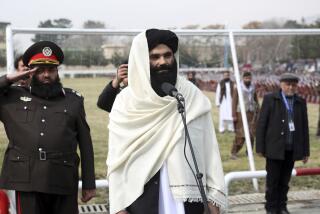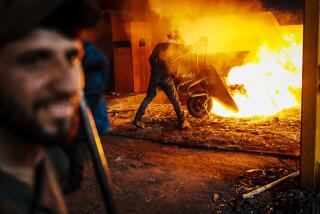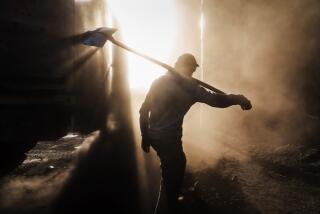Militants deepen their foothold in Afghanistan’s north
- Share via
KUNDUZ, AFGHANISTAN — The hulks of burned-out fuel tankers on the doorstep of this provincial capital stand as scorched testament to the growing reach of the Taliban and other insurgents across Afghanistan’s once-stable north.
As the Obama administration moves into a crucial phase of deliberations over the U.S. military presence in Afghanistan, residents of a widening arc of territory a half-day’s drive from the capital, Kabul, describe daily lives fraught with danger as the militants’ foothold becomes stronger.
Just beyond the Kunduz city limits, insurgents brazenly tool around in Ford Rangers stolen from the Afghan police. A Taliban-run shadow administration, complete with a governor, a court system and tax levies, wields greater authority than its official counterpart in much of Kunduz province.
Traffic is thin and nervously quick on the main highway, where insurgent roadblocks and ambushes have been common, spurred in part by a new NATO supply line running south from Tajikistan.
“There’s no safety now -- it’s war,” said Abdul Rahman, an ice cream vendor who is afraid to travel to his home in an outlying district. “The Taliban aren’t in the city yet, but they’re out there everywhere in the countryside around here. I’m scared.”
Many Afghans fear that the hinterlands will become even more dangerous if the commander of allied troops in the country, U.S. Army Gen. Stanley A. McChrystal, pushes ahead with plans to relinquish remote outposts and instead concentrate on defending population centers.
Although the number of insurgents in the north is relatively small compared with that in the south -- the Taliban’s birthplace and traditional stronghold -- military officials and local leaders describe a worrying and unusually disparate buildup of insurgents in the region.
The influx is fed by a variety of militant factions: Al Qaeda-linked Uzbeks and Chechens with a particular reputation for ruthlessness, Taliban fighters who have been pushed northward by NATO offensives in the south, foot soldiers loyal to several different Pakistan-based insurgent commanders.
“It’s definitely a mixing pot,” said Navy Rear Adm. Gregory Smith, a spokesman for McChrystal.
Kunduz province, sandwiched between Tajikistan to the north and Baghlan province to the south, is in many ways a microcosm of the country, with an ethnically mixed population, longtime standing as a fighters’ haven and smuggling route, and a shrinking sphere of government influence outside major population centers.
It is also a strategic pivot. When the Taliban controlled Afghanistan, Kunduz was the fundamentalist movement’s administrative center for all the north. Together with Baghlan, it is the gateway to the Hindu Kush, the towering mountains that represent the only real physical barrier between the north and Kabul.
“If Kunduz fell, the Hindu Kush would be in the hands of the Taliban, and this would be a disaster,” said Mohammad Omar, the provincial governor, who recently survived a Taliban assassination attempt.
The plethora of insurgent groups operating in Kunduz and Baghlan offers a rare glimpse of the shifting rivalries and alliances between the Taliban and Al Qaeda. A key link between the two is the feared Soviet-era insurgent commander Gulbuddin Hekmatyar, a Kunduz native.
Hekmatyar’s fighters frequently stage attacks against Western troops and Afghan security forces in the north. But in what analysts describe as a classic Afghan hedging technique, the commander is making political inroads in the region, even as he keeps up the battlefield pressure.
Many think Hekmatyar is positioning himself for possible power-sharing in a new administration likely to be led by President Hamid Karzai. The Afghan leader, facing a runoff challenge from his former foreign minister, Abdullah Abdullah, is cementing ties with powerful warlords such as Hekmatyar, ignoring Western discomfort over such alliances.
“Hekmatyar is looking for more political influence here,” said Habiba Urfan, a provincial council member in Kunduz. In Baghlan, an entire tier of provincial officials, from the governor on down, is allied with Hekmatyar, intelligence officials say.
Insurgents operating in the north have also displayed an acute awareness of the rifts between NATO allies -- seeking, in particular, to exploit tensions between McChrystal’s leadership team and the Germans, who make up the main Western contingent in this part of the country.
This month, insurgents ambushed a 40-truck fuel convoy only a few miles outside the gates of Kunduz city. The attack was within sight of a hilltop German military base, but no troops responded; a spokesman said none were available.
That hands-off approach stood in sharp contrast to the Germans’ reaction in early September when another fuel convoy was attacked by insurgents a short distance from Kunduz. Fearing that two hijacked tankers could be used as massive vehicle bombs against their base, the Germans called in a U.S. airstrike, incinerating civilians and insurgents alike.
An estimated 90 people were killed, though the toll is sharply disputed.
McChrystal, who has vowed to keep Afghan civilian deaths in check, personally flew to the scene to investigate, and some of his aides made it clear they believed the Germans had overreacted. The incident also caused an outcry in Germany, where support for the Afghan mission is faltering.
Militant commanders “are very much aware of our domestic political situation, and they plan attacks accordingly,” said Lt. Col. Carsten Spiering, a spokesman at the Germans’ Kunduz base. “They know it is a problem when our troops are killed, and they know it is a problem when Afghan civilians are killed.”
A more insidious pattern is the insurgents’ steady blocking of reconstruction projects that could help build goodwill between locals and North Atlantic Treaty Organization forces.
Even modest efforts to change Afghans’ lives for the better are often thwarted.
This month in Kunduz’s troubled Chardara district, the Germans finished building a little bridge over a shallow, muddy creek. Days later, Spiering said, the Taliban blew it up.
Local Afghan officials are frustrated. Their own security forces are spread far too thin, they say -- in Kunduz, fewer than 1,000 police officers safeguard a province of 1.4 million people. Attacks against the Afghan police are relentless: In August, Gov. Omar’s brother, a district police commander, was killed in a clash with the Taliban.
Provincial officials acknowledge that pinpoint raids over the last month, some carried out by U.S. special forces, have taken a toll on the insurgents’ command structure. But Taliban leaders say it is they, not the Western military, who have seized the initiative.
“Thanks be to God, we’re strong here,” said a Taliban leader who calls himself Mullah Ahmad, speaking by telephone from an undisclosed location. “We’re very active in Kunduz. Historically, this area is our home, and people cooperate with us.”
Ahmad, who describes himself as the deputy governor in the Taliban shadow government, said fighters would continue to harry NATO’s new northern supply line, which was set up after the Taliban repeatedly burned and hijacked trucks traveling from Pakistan via the Khyber Pass.
“We hit them just the other day, and we will hit them again,” he boasted.
Local officials dispute the Taliban claims of popular support, saying many villagers who cooperate with the insurgents do so out of fear. But they acknowledge that high jobless rates make the area a recruiting ground for the militants.
“You have to find something for the unemployed youth who join up mainly because they don’t have other prospects,” said Mohammed Razzaq Yacoubi, Kunduz’s provincial police chief. “You’re not going to solve the problem by having a tank at the entranceway to every alley.”
In the north, even more than elsewhere in Afghanistan, Western forces seem at a loss as to how to distinguish friend from foe.
“Everywhere we go, they smile and wave at us, and then they turn their guns on us,” said Spiering, the German military spokesman. “People want to be on the side of the winner. And they don’t know yet who that is going to be.”
--
More to Read
Sign up for Essential California
The most important California stories and recommendations in your inbox every morning.
You may occasionally receive promotional content from the Los Angeles Times.













